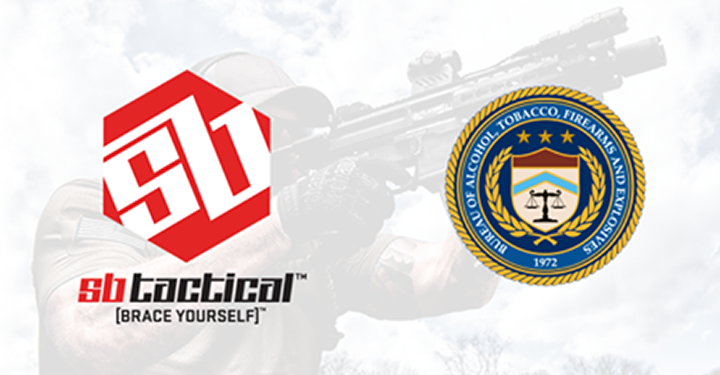ATF Creating Pistol Brace Ban Through the Back Door
An estimated 700,000 owners and users of a popular shooting accessory in the U.S. may soon be left in the dark as to whether their makeshift pistols are legal thanks to a non-public change in federal policy.
International Sportsman reported in June on a long-anticipated move by the U.S. Bureau of Alcohol Tobacco Firearms and Explosives (ATF) to put a stop to owners of AR-15s, AK-47s, and other semi-automatic rifles modifying their pistols to be shoulder-fired by use of what’s known in the industry as a “pistol brace.”
Now it appears, based on several sources, the ATF is making that move on the down-low (see analysis below).
To recap the situation: In 2012 the pistol brace was introduced to the firearms market as a temporary buttstock solution. It proved effective for those wishing to avoid the otherwise-required federal paperwork, or who prefer a way to legally conceal automatic and semiautomatic firearms. The popularity of pistol braces soared and became a favorite among gun owners with disablilities who find it difficult to handle and fire a rifle of conventional length.
ATF wavered for years on exactly how to approach this innovation. From our June article:
ATF has maintained for years that 26 inches is the maximum length for a concealable firearm. Barrels, according to ATF’s rules, must be 16 inches or longer with a buttstock, or it falls under the National Firearms Act (NFA) restrictions for automatic guns. Without a buttstock, an AR-15 pistol (for example) may have any barrel-length.
The introduction of the pistol brace in 2012 created a gray area in the law — being not necessarily a buttstock but at the same time functioning as one. When Sig Sauer unveiled their new SB15 Pistol Stabilizing Brace, it was intended to be strapped around the forearm, improving stability when firing. Many pistol owners saw an opportunity to instead use the brace like a stock, pressing it up into the shoulder and using it as a cheek rest like with a rifle.
This led to a string of ATF rulings. In 2014, ATF nixed “shouldering braces,” arguing a brace effectively turns a pistol into a short-barreled rifle. The bureau doubled down in 2015 at the end of the Barack Obama presidency, clarifying “illegal shouldering.”
At the onset of the Trump Administration, however, the ATF reversed much of its stance and allowed for the use of braces in “situational,” “sporadic,” and “incidental” uses.
In June, U.S. Rep. Matt Gaetz sounded the alarm that the ATF was poised to begin regulating pistol braces without the purview of Congress or even the White House. Gaetz, while praising the Donald Trump Administration for its many defenses of the Second Amendment, also pointed out that the same administration banned “bump stocks” to answer a swell of criticism stemming from gun control activists. He urged constituents to contact their Congressmen and Senators in response, as many gun-rights advocacy groups have done.
So far, the ATF has not messaged on any changes to its interpretation of what constitutes a pistol, though firearms enthusiasts are already spreading the word.
The Military Arms Channel, referring to a post from regulatory legal firm Wiley Rein LLP, criticized the yet-unspoken change coming from ATF.
“… [I]t is something you should take very seriously because of recent actions by the BATF that will affect any owner of AR15 pistols, AK pistols, HK pistols, etc.,” the blog noted via its primary Facebook Page. “Yes, this means your Saint AR pistol or your Draco. That’s exactly what the ATF is targeting.”
Curtis Hallstrom of the VSO Gun Channel, which researches and tests firearms, speculates that the redefinition of pistol-brace firearms as AOWs (federal-ese for “any-other-weapon”) rather than machine guns and short-barreled rifles, is an enforcement mechanism. AOWs would require a $5 tax stamp (and the requisite federal registration) as opposed to $200 in the latter category. But without the proper stamp, under the National Firearms Act (NFA) the gun would therefore be illegal and be subject to confiscation. “It is very important that we get in contact with our elected officials,” he said.
ANALYSIS
It now appears Congressman Gaetz’s earlier concerns have been justified — though precise information is difficult to come by at the time of writing. Here’s why it’s so hush-hush:
President Trump issued an executive order in October 2019 banning the practice of arbitrary changes to agency code without first being published in the Federal Register and being subject to public comments. So what we are left with is a phantom, verbal-only shift in ATF’s approach to pistol braces — quite possibly in order to avoid controversy and Congressional scrutiny, and maybe also as a means to discourage sales, manufacturing, and modification without lifting a muscle to do it.
“Given the private nature of ATF’s classification rulings, and the subjective nature of the analysis, it is extremely difficult to know for sure whether specific firearms fall within the new interpretation,” Wiley Rein pointed out. “This appears to be part of a continuing trend at ATF to apply firearms statutes in a more restrictive manner without informing the public.”
The firm noted millions of AR-15 style pistols could soon be considered “too large, or too heavy” to fall within ATF’s new, unspoken criteria, “thereby making them unregistered NFA weapons, and subjecting manufacturers and gun owners to criminal prosecution.”
According to the firm, the loophole is quietly being closed on pistols that: have rifle-style sights, use rifle-caliber ammo, have rifle-length barrels, maintain a heavy weight, can accept 20-100 rounds and which contribute to the overall weight of the gun, and are front-heavy imbalance when held in one hand.
In the meantime, owners of pistol braces who catch wind of this change will be in somewhat of a holding pattern. Whether it’s Trump or Biden as the victor after Nov. 3 will determine how the White House will approach the ATF’s own loophole of not publicizing their interpretative changes.
Andy Hogue is a longtime veteran of legislative politics and journalism. He makes frequent appearances on television and radio shows in the Austin area, his writing has appeared in numerous national and international media outlets. He has served as speechwriter for two state officials, publicity director for several projects at The Alamo, and was constituent services director for one of the last conservative Austin City Councilmen. For fun he likes to unload 13 rounds from his Browning Hi-Power.


